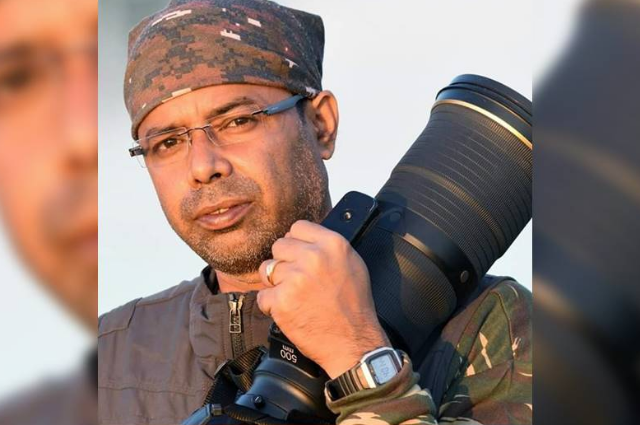
Introduction:
The year was 2000. A young man a little over 20 started roaming about the forest ranges with his Nikon camera in and around his small town of Bishnupur (once called ‘Bon Bishnupur’) to fulfill his long-cherished dream to become a wildlife photographer that haunted him from his early childhood. The young man was none but Biplab Hazra who is now a wildlife photographer of international repute.
Human-Animal Conflict:
But the escalating human-animal conflict in the area frequented by herds of migratory elephants from neighboring states including Jharkhand and Orissa moved him so much that he could not help captivating those poignant moments in his ordinary camera. His heart was overwhelmed with grief witnessing unspeakable tortures perpetrated by the villagers on the herds of migratory pachyderms for eating up the cash crops like paddy, sugarcane, and potatoes grown by the farmers around the year. The villagers desperate to protect their crops chased the elephants hurling fireballs made of jute sacks soaked in kerosene and burnt mobile and poking the elephants with pointed lance-like brick-red hot steel rods. Unwittingly, all these tortuous sights out of the struggles for existence between men and elephants anguished his conscience so much and his mere pastime of wildlife photography transformed him into an ardent wildlife conservationist in spirit. “Now I prefer to be recognized as a wildlife conservationist”, reminisced Biplab Hazra, the winner of the most prestigious Sanctuary Wildlife Photographer of the Year, 2017 and Nature in Focus Photographer of the Year, 2017.
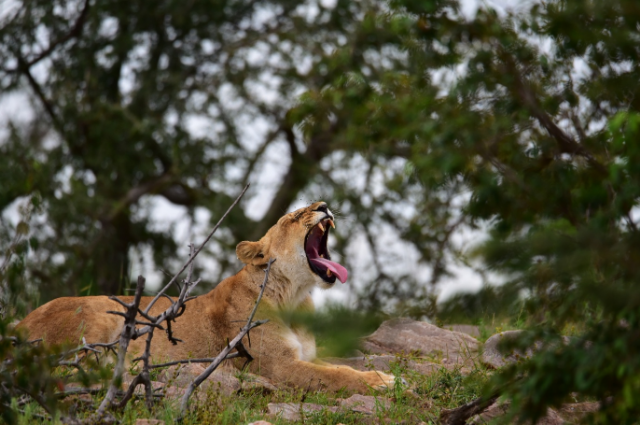
Long Journey as a Wildlife Photographer:
The 40-year-old wildlife photographer cum wildlife conservationist just whiled away in the nearby forest ranges. Later moved by the sight of the maltreatment of elephants by the villagers, he purchased a Nikon D750 to entrap the conflicts for survival between men and elephants in the villages in and around the forest lands of Bishnupur. From then on Mr. Hazra’s journey as a wildlife photographer cum conservationist continued unabated. His love for wildlife hauled him to Jim Corbett National Park, a forested wildlife sanctuary in Uttarakhand, Kaziranga National Park in Assam, Tadoba Andhari National Park in Chandrapur district in Maharashtra, and Mangalajodi and vast ranges of forest land and coastal areas in Orissa, Jharkhand, and others. Above all, he was given the golden opportunity by the Karnataka Govt of an African safari in Maasai Mara National Reserve, an area of preserved Savannah wilderness in South-Western Kenya, along the Tanzanian border.
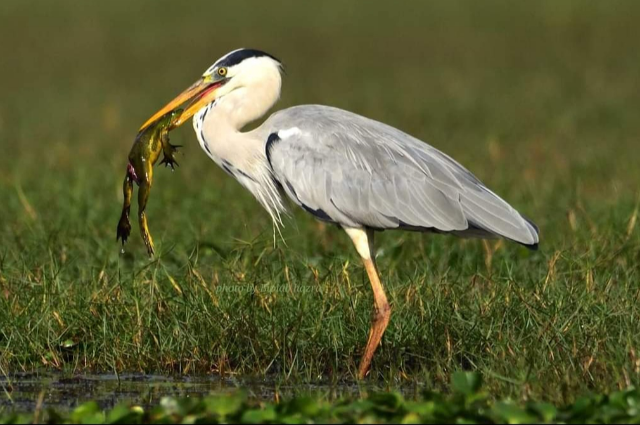
Sanctuary Wildlife Photographer of the Year 2017:
Biplab Hazra became a wildlife photographer of international repute after he has declared the Sanctuary Wildlife Photographer of the Year 2017 for his chef-d’ oeuvre captioned “Hell is Here”, felicitated by a Mumbai-based wildlife photography magazine Sanctuary Asia. The photograph was taken in the forest land of Bishnupur of Bankura district of West Bengal.
The award-winning photograph tells a heartrending tale of man-elephant hostility. A full-grown elephant in the photograph is seen followed by a panic-stricken calf. Both are trying to flee crossing an asphalt road ripped through the forest. The mother elephant disregarding the crowd is running fast with the calf entangled by the reddish yellow flame of fire in its rear endeavoring its best to reach its mother. The calf is screaming both in sustaining burn injuries and fear. In the backdrop of the absconding pachyderms, there is a crowd of jeering men flinging flaming tar balls and crackers. The burning fireballs lobbying in the mid-air seem like a part of the wild celebration.
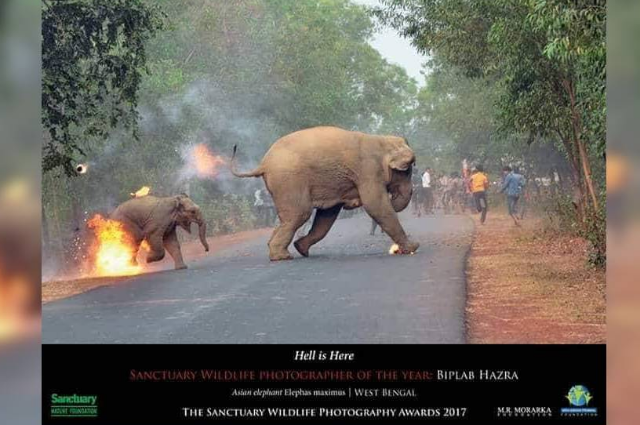
The photograph captioned “Hell is Here” went viral in newspapers and websites around the world. Hazra’s photograph exposing such a bitter hostility between man and jumbos deserved him to be adorned with the most prestigious Sanctuary Wildlife Photographer of the Year 2017. Sanctuary Asia, on its Facebook page, described the incident entrapped in the award-winning photograph with a stark caption:
"In West Bengal, this sort of humiliation of pachyderms is routine, as it is in the other elephant-range states of Assam, Odisha, Chhattisgarh, Tamil Nadu, and more. India is the world's stronghold for the Asian elephant and boasts over 70 percent of the global population of the species. But this achievement rings hollow as vital elephant habitats and routes continue to be ravaged, and human-elephant conflict escalates to a fatal degree.”
However, according to Hazra the calf sustaining burn injuries survived the brutal attack. But the extent of burn injuries that the calf sustained or whether it succumbed later was unknown. Showers of condemnation poured on the inhuman villagers who were desperate to protect their crops for their sustenance. According to Anirudh Nair, Sanctuary Asia editor, the main objective of conferring the award to the photograph was to raise awareness of the practice of violence against elephants in West Bengal and other parts of the country.
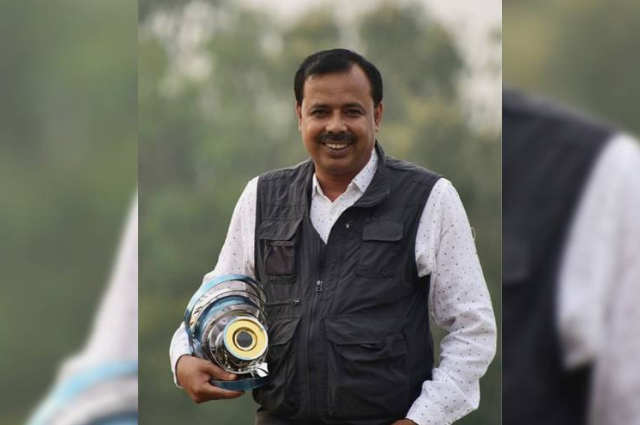
NiF (Nature in Focus) Photographer of the Year, 2017:
In the very same year, Biplab Hazra had already been the Winner - Of Conservation Issues and NiF (Nature in Focus) Photographer of the Year, 2017 in August. The award-winning photograph titled “Fire and Fury” showing a mother elephant followed by its calf evading fireballs and crackers thrown by irate mobs projects human-elephant conflict, the biggest conservation issue in India. Mr. Hazra also won an African safari in Mara Mara National Reserve, an area of preserved Savannah wilderness in South-Western Kenya, along the Tanzanian border for his poignant shot awarded by the Karnataka Govt. His photographs in his serial works on the breeding habits and migration of Oliver Turtle have also been awarded by NiF.
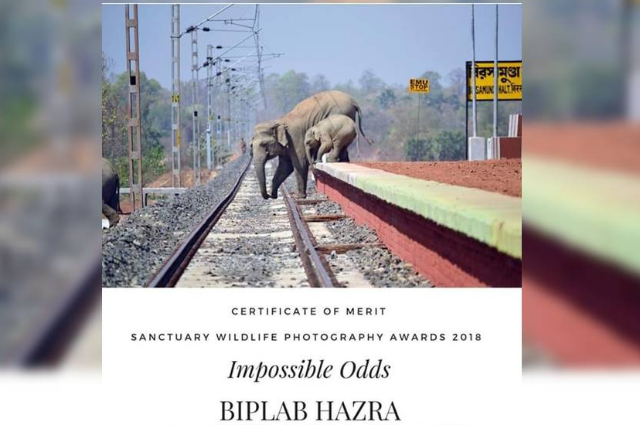
Sanctuary Wildlife Photography Awards 2018:
Another masterpiece entrapped in Hazra’s camera won him a certificate of merit awarded in Sanctuary Wildlife Photography Awards 2018. Very few could ever be able to win those prestigious awards for two consecutive years. He is the first Indian photographer to attain this credit. The photograph captioned “Impossible Odds” tells that the elephants displaced from their natural habitats are facing hardships in search of food and shelter.
One fine winter morning his eyes were glued to a sight. A herd of elephants was trying to cross the railway track at Birsa Munda railway halt in Bankura district of West Bengal penetrating a dedicated elephant corridor. Though a grown-up pachyderm has almost kept its front legs on the railway track, the young calf cannot muster the courage to follow suit. The ‘impossible odds’ that the elephants have to face in their daily existence have been impersonated in the photograph.
Hazra prescribed with resentment, “The elephant corridor would have been saved provided the platform had been built at least 100 meters away from the existing area. What is horrific is that a train runs through the station without halting. I have not seen a single person getting on or off at this railway halt that has nothing including fans, switches, and electric wires except but a ticket counter to boast of.” Bollywood actor Randeep Hooda after watching and referring to his photograph “Impossible Odds” appealed to the Government of India to “Develop infrastructure and be sensitive towards voiceless creatures”.

HIPA (The Hamdan Bin Mohammed Bin Rashid Al Maktoum International Photography Award (2020 – 2021):
Biplab won the “HUMANITY” category Fifth Prize in the Tenth Season (2020-2021) conferred by “HIPA” (The Hamdan Bin Mohammed Bin Rashid Al Maktoum International Photography Award). He was awarded for his photograph captioned “Rescue” snapped in a village in West Bengal. It entraps the soul-soothing situation of an elephant that drowns in deep water in a village and the villagers gather to rescue it. “I am deeply moved as the photograph portrays a good bonhomie between the man and the elephant for which I have been working for decades.” Biplab Hazra expressed his satisfaction.
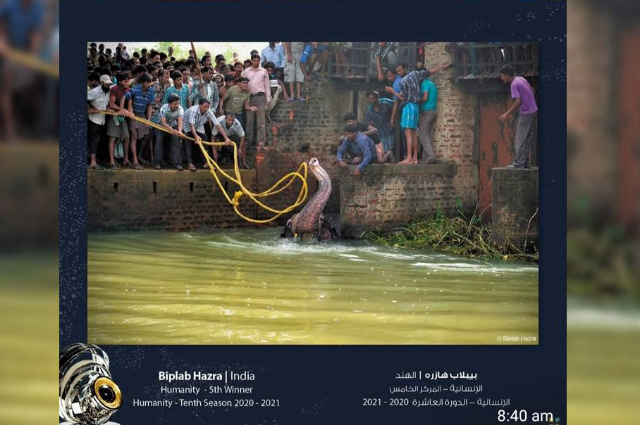
Special Honours on the Occasion of Azadi Ki Amrit Mohatsav:
Biplab Hazra was showered honors with honors by the Archaeological Survey of India, Kolkata Circle. He was invited to hoist the Indian National Flag in the precinct of Rash Manch, one of the remarkable temples of Bishnupur, the Temple Town.
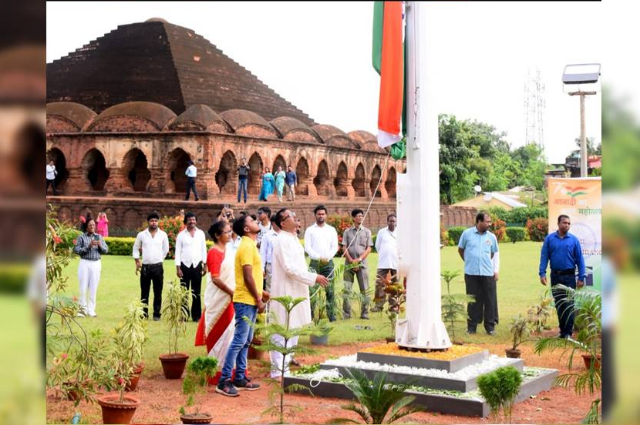
Effects of Hazra’s Works:
His photographs “Hell Is Here” and “Fire and Fury” also moved The Supreme Court of India. Upon hearing the counsel of Writ Petition(s) (Civil) No(s) 489/2018 between PRENA SINGH BINDRA & ORS. Petitioner(s) VERSUS Union OF INDIA & ORS Respondent(s) made the following order:
“Learned Additional Solicitor General has placed an affidavit of the Ministry of Environment, Forest and Climate Change in which it is stated that instructions have been issued to all the concerned Principal Chief Conservators of Forest (PCCF) to desist from using any method of torture of elephants.
The affidavit is taken on record.
Learned counsel for the State of Karnataka says that she has Instructions that all the spikes that have been obtained on the tender will be removed and henceforth spikes or any other method will not be used to derive elephants.
We direct that any existing tender will remain stayed.
Similarly, we stay the tenders issued by the State of West Bengal. State of Jharkhand and State of Odisha in this regard.
Wherever the spikes or fireballs are used for driving elephants, remedial steps should be taken by the concerned States for removing the spikes and desisting from using the fireballs.
List the matter on 7th August 2018.”
The notice with the subject “Torture to elephants during the driving” read “This has come to the notice of the office that in certain cases during elephant driving operations elephants are subjected to torture by throwing fireballs and by piercing pointed rods on the hind position of the elephant. These atrocities not only cause pain to elephants but also results in enhancing the loss of property (house damages) and human death/injury by the irritated elephants. Such action by some people is against the Wildlife (Protection) Act, 1972 and results in enhanced human-elephant conflict.
You are hereby directed to inform all the Range Officers and Beat Officers that under no circumstances elephants should be subjected to inhumane behavior of burning them by fire or causing injury on their back by pointed hullah by anyone. If someone is found involved in such activities, necessary action under Wildlife (Protection) Act, 1972 should be taken against him.”
However, the human-elephant conflict in the South Bengal districts of West Bengal has largely been replaced by human-elephant bonhomie. This bonhomie is well-vindicated by his photograph, "Rescue” which was awarded HIPA on humanity category in Sept 2020. Through uninterrupted campaign and contact with the residents of the areas frequented by elephants seasonally or permanently, Mr. Hazra has been able to ingrain an elephant consciousness among a large section of people who instead of perpetrating unspeakable tortures now love and worship elephants as the living incarnation of Lord Ganesha. Reciprocally, the destruction caused by elephants in those areas has significantly reduced, too.

Significant contribution:
Biplab’s award-winning photographs captivating the poignant moments of the escalating human-animal conflict in the area frequented by herds of migratory elephants from neighboring states including Jharkhand and Orissa have been able to raise a great amount of attention in our country and throughout the world as well. His photograph under the title “Humans cruelty chase away elephants using firecrackers” got placed in the September 2020 issue (volume 40) of the Mumbai-based prestigious wildlife magazine “Sanctuary Asia”. Besides, scores of organizations working cordially and sincerely on wildlife protection and conservation are keeping regular contact with him and his works.
Featured in Dailies and Journals of National and International Repute:
Mr. Hazra’s award-winning photographs and his works on wildlife photography and conservation have been featured and mentioned in the most prestigious dailies, magazines, journals, tabloids, etc of national and international repute. A few of them are mentioned here.
They are “Photo of elephant and calf fleeing fire-throwing mob wins to prize” in The Guardian on Nov 7, 2017, “The horror elephants face in India – in one heartbreaking photo” in The Washington Post, by Cleve R. Wootson Jr., a White House reporter of The Washington Post, on Nov 8, 2017, “Why Can’t We Protect Elephants” in The New York Times by Maggie Shipstead, an American novelist, on Nov 18, 2017, “India award for burning elephant photo” in BBC News on Nov, 2017, “Shocking Photo Shows Elephants Fleeing a Fire-Wielding Mob” in National Geography by Michael Greshko on Nov 10, 2017, “Sanctuary Wildlife Photograph Award 2017” in Sanctuary Asia, “The lens of life” in “evolve” section of The Statesman by Buddhadev Nandi on Feb 3, 2019, “The fire between us : Why the Bankura elephants faced ire” in The Hindu by Janki Lenin, a filmmaker and writer of international repute, on Nov 25, 2017, “‘Fiery Hell’ of elephants wins top spot at Sanctuary Wildlife Photography Awards” in The Times of India on Nov 6, 2017, “Hell is Here : Powerful photo captures elephant, calf escaping flaming tar balls, crackers” in Hindustan Times on Nov 7, 2017, “How to save India’s elephants from killer rail tracks” in Down to Earth by V Sundararaju on Feb 6, 2019.
Besides, hundreds of features and articles with his photographs of human-elephant conflict have been published in national and international dailies and magazines including “Deccan Herald”, “Firstpost”, “Mumbai Mirror”, DNA, “New York Post”, “The New India Express”, “QUARTZ INDIA”, “It’s Nice That”, “VIRALNOVA”, “News Mail” etc.
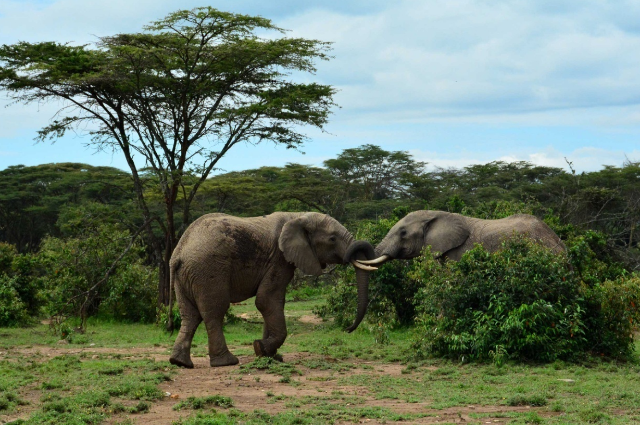
Mr. Hazra’s Concern about Elephants:
Needless to say, India is the world's stronghold for Asian elephants. The country boasts of being the home ground of over 70 percent of the global population of pachyderms. Besides, West Bengal covers a major part of the elephant corridors of the country. “Ironically, human-elephant conflict in the state especially in the South Bengal districts like Bankura, West Midnapore, and Purulia escalates to a fatal degree because of continuous ravages of the elephant habitats due to developmental projects, ever-increasing urbanization, human encroachment in the wildlife corridors and, above all, dearth of food and water. Elephants are left with no choice but to migrate. Even a few herds of elephants have already been resident here. On the other hand, frequent migrations of elephants into human settlements wreak havoc damaging cash crops and properties and causing casualties. Naturally, human-elephant relation has plummeted here critically”, Biplab Hazra, the brick-kiln owner with his face brick-red in lividity explained.
Now Biplab’s main concern is how to save the elephants from the inhuman practices of throwing fire torches and crackers by elephant chasers (locally called ‘Hula Party’) to drive away pachyderms. “Needless to say, elephants are sustaining serious burn injuries on their soft skin thanks to such ruthless practices adopted by the villagers. As a result, the elephants tend to become more aggressive, destroying cash crops and even causing human casualties. To add to these, high voltage electric fencing to restrict the free movement of the elephants has made the situation graver.” Mr. Hazra lamented.
“Deaths of elephants due to electrocution in many parts of our country are common headlines now. A few months ago two full-grown elephants were killed in electrocution in Nepura village of Midnapore district. Ironically, the villagers observed the last rites of the two dead elephants.”He added.
Mr. Hazra’s Prescriptions to Save Elephants from Tortures:
“Installation of electric fencing to obstruct the free movement of the pachyderms is making the situation more acute. They are just dispersing the herds to and fro. Above all, high voltage electric fences are being erected indiscriminately infringing the Prevention of Cruelty to Animals Act of the Parliament of India enacted in 1960 to prevent the infliction of unnecessary pain or suffering on animals. Besides, many railway tracks pass through dedicated corridors causing inconveniences to the herds. The apex court in its observation restrained the government from processing tenders issued by it for the supply of burnt mobile oil to chase away elephants. Unfortunately, the inhuman practice is still prevalent in many parts of the country.” Mr. Hazra lamented.
According to Mr. Hazra, as crop raiding behavior is being handed down among the progeny of the grown-up elephants, long-lasting solutions must be innovated to restrain the animals from invading croplands without escalating the conflict between men and elephants. He explained that LED lights with sirens and bio-acoustics are being used in some parts of Orissa and Chhattisgarh to scare away elephants. But they do not seem to be permanent solutions. Elephants being intelligent enough might withstand fears caused by those devices.
According to Biplab Hazra, the Beehive Fences may prove a lasting solution to repel elephants from farming lands. Mr. Hazra said, “The method is widely adopted in Kenya called ‘Kenyan Top Bar Hives’ and Langstroth Hives. Beehive Fences are cheap and eco-friendly methods as they are made without concrete materials. They are just dummy hives linked together with interconnecting wire gaping a few meters from one another. They are hung in a specific formation so that the swarms of bees in the beehives release in the swing caused by the touch of one of the hives by elephants. This method has proved fruitful enough in many parts of Kenya. Elephants are scared of the humming sound of the swarms of bees as they are conscious of the painful stings of the bees. Above all, the Beehive Fences project also enables the villagers to collect optimum amounts of honey.”
Conclusion:
The forty-year-old Biplab Hazra, an optimistic wildlife photographer cum wildlife conservationist, concluded, “Though we have miles to go, I see in my vision that someday India will be the land of peaceful co-existence between men and elephants and also other wild animals.”
References:
- Day-to-day direct conversations with Biplab Hazra, my next-door neighbor
- “The horror elephants face in India – in one heartbreaking photo” in The Washington Post by Cleve R. Wootson Jr. on Nov 8, 2017
- “Photo of elephant and calf fleeing fire-throwing mob wins to prize” in The Guardian on Nov 7, 2017
- “Why Can’t We Protect Elephants” in The New York Time by Maggie Shipstead, an American novelist, on Nov 18, 2017
- “India award for burning elephant phot”o in BBC News on Nov 7, 2017
- “Shocking Photo Shows Elephants Fleeing a Fire-Wielding Mob” in National Geography by Michael Greshko on Nov 10, 2017
- “Sanctuary Wildlife Photograph Award 2017” in Sanctuary Asia
- “The fire between us: Why the Bankura elephants faced ire” in the Hindu by Janki Lenin, a filmmaker, and writer of international repute, on Nov 25, 2017
- “Fiery Hell” of elephants wins top spot at Sanctuary Wildlife Photography Awards” in The Times of India on Nov 6, 2017
- “Hell is Here”: Powerful photo captures elephant, calf escaping flaming tar balls, crackers” in Hindustan Times on Nov 7, 2017
- “How to save India’s elephants from killer rail tracks” in Down to Earth by V Sundararaju on Feb 6, 2019
